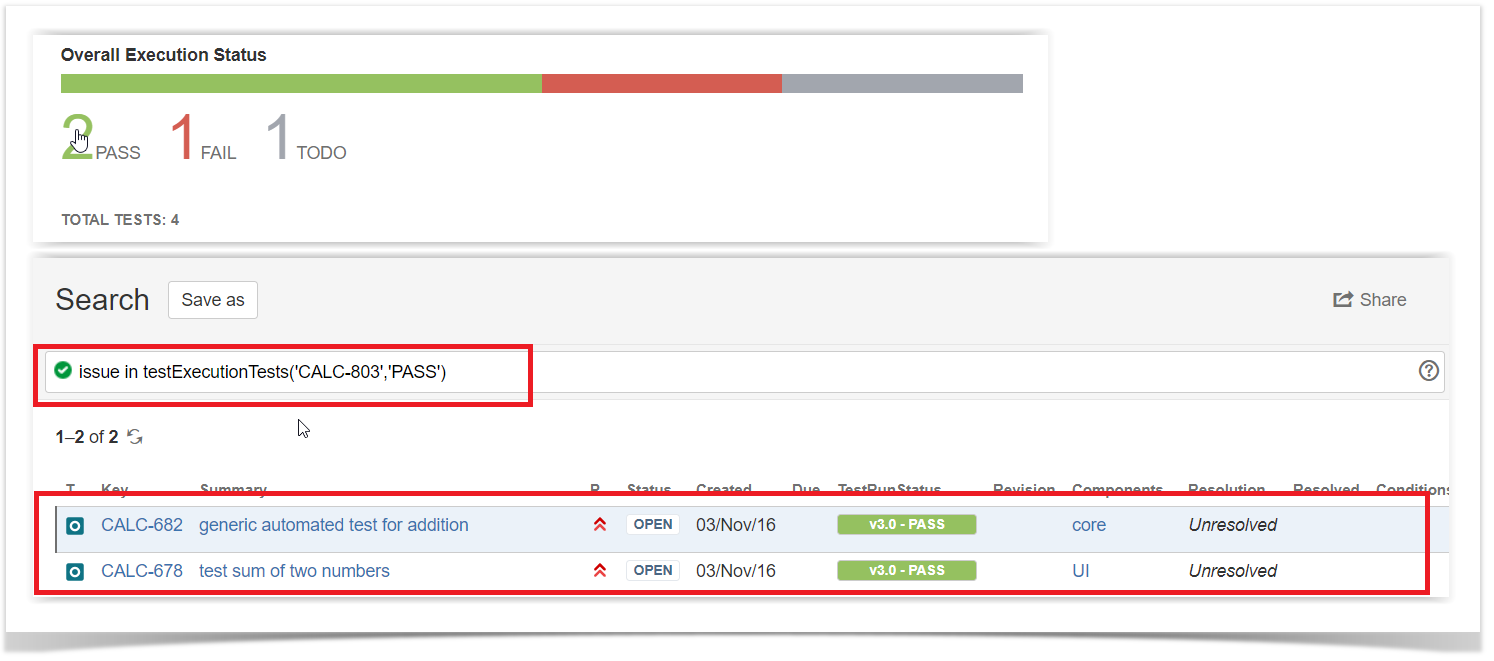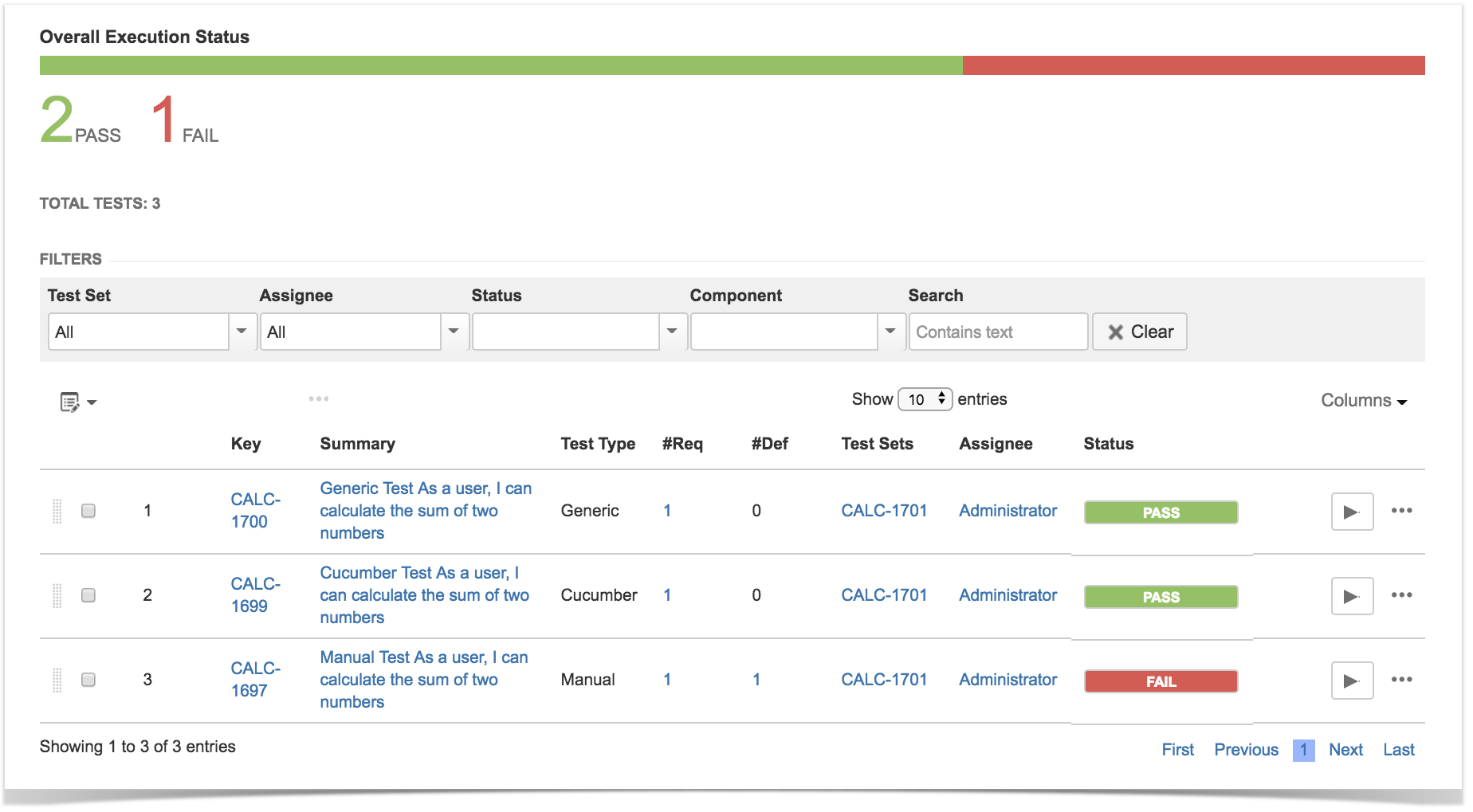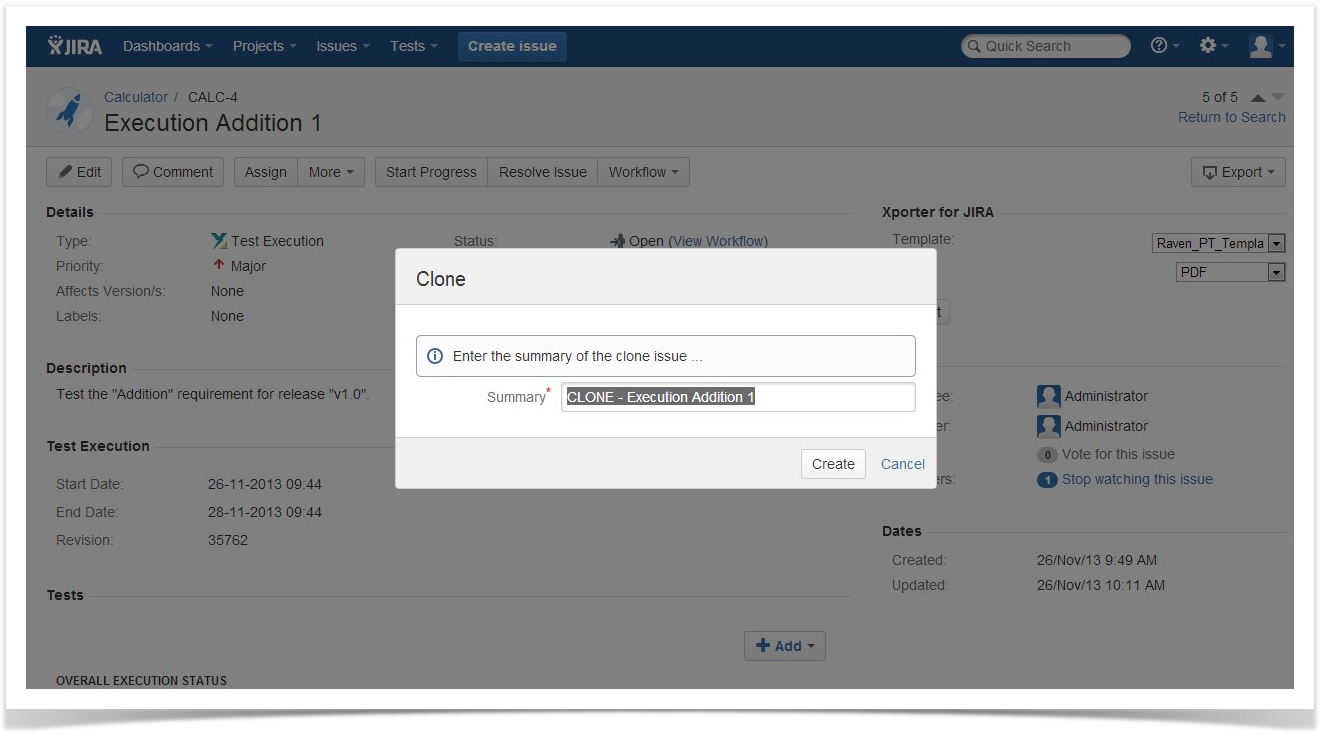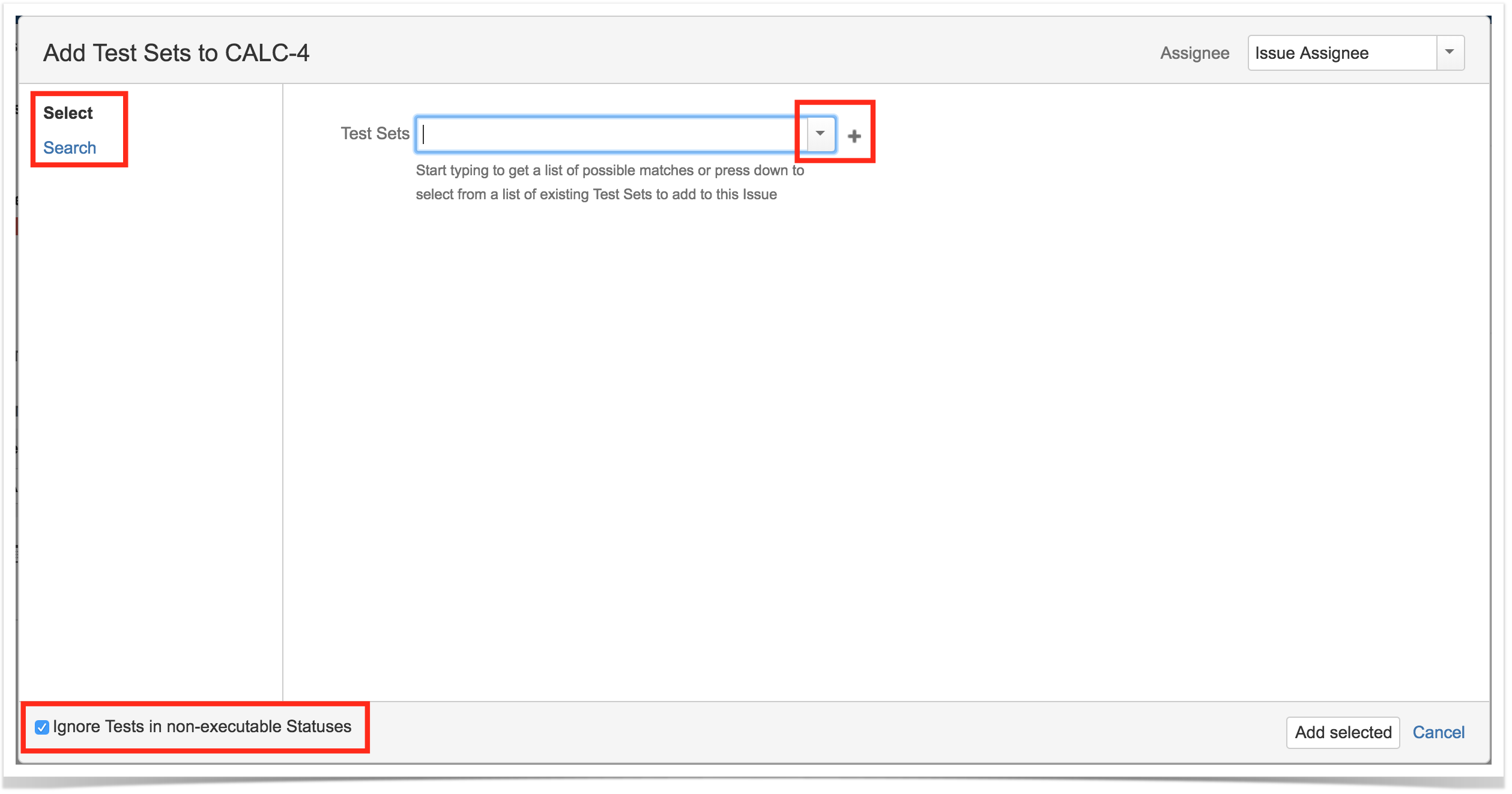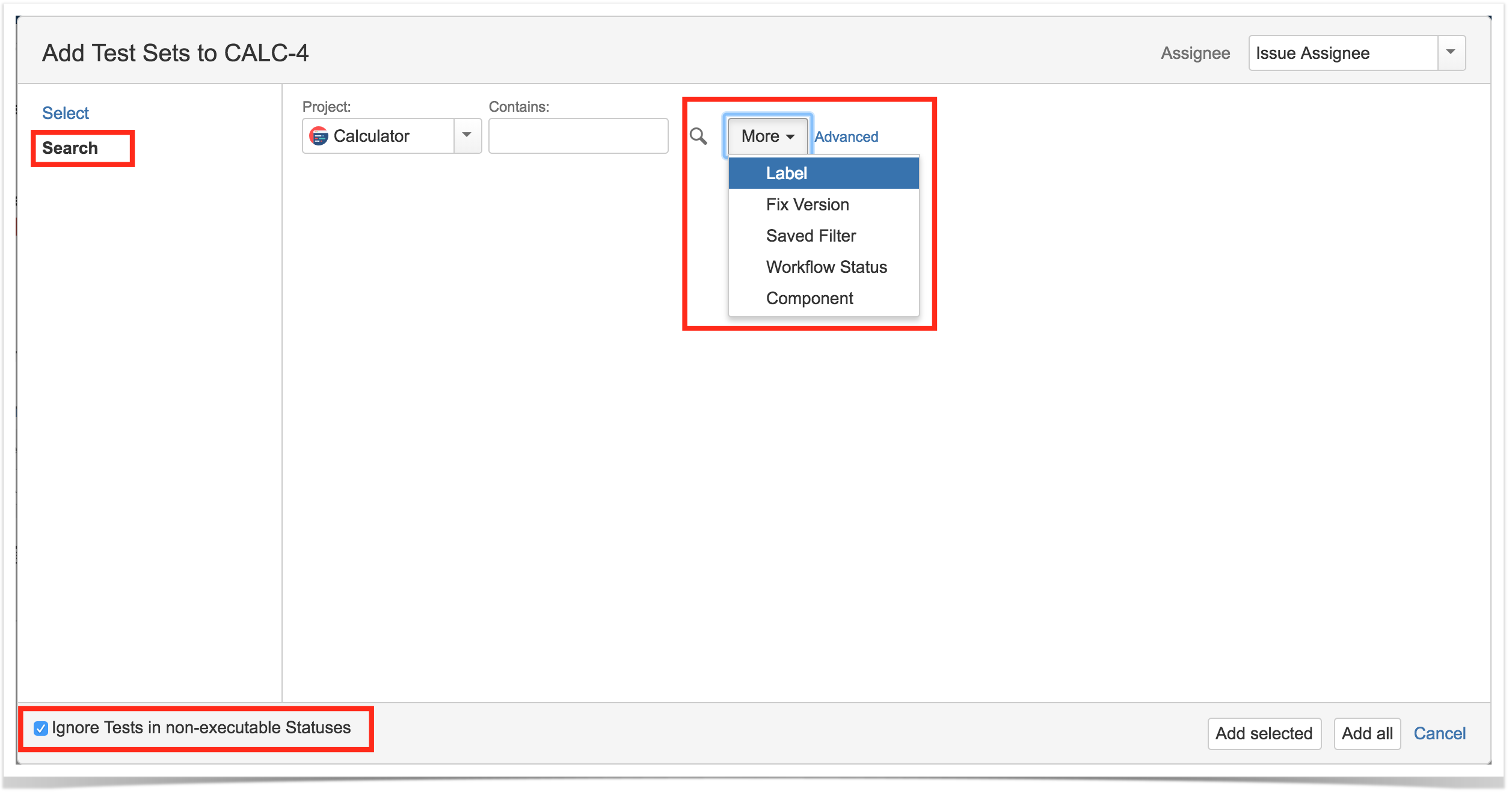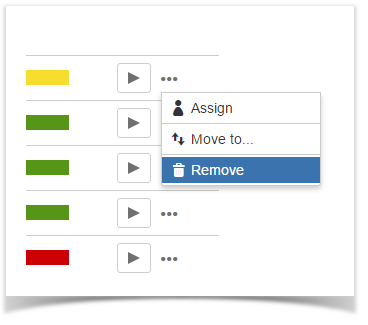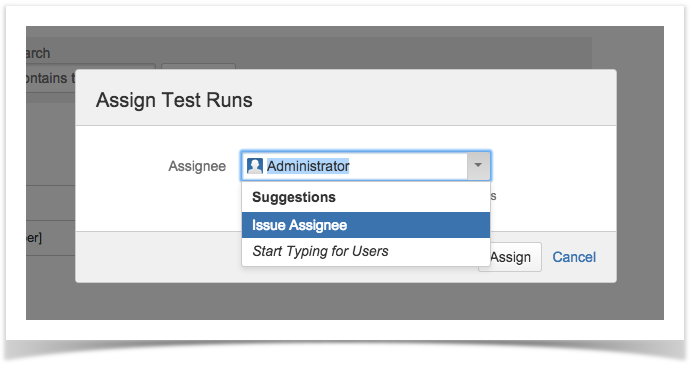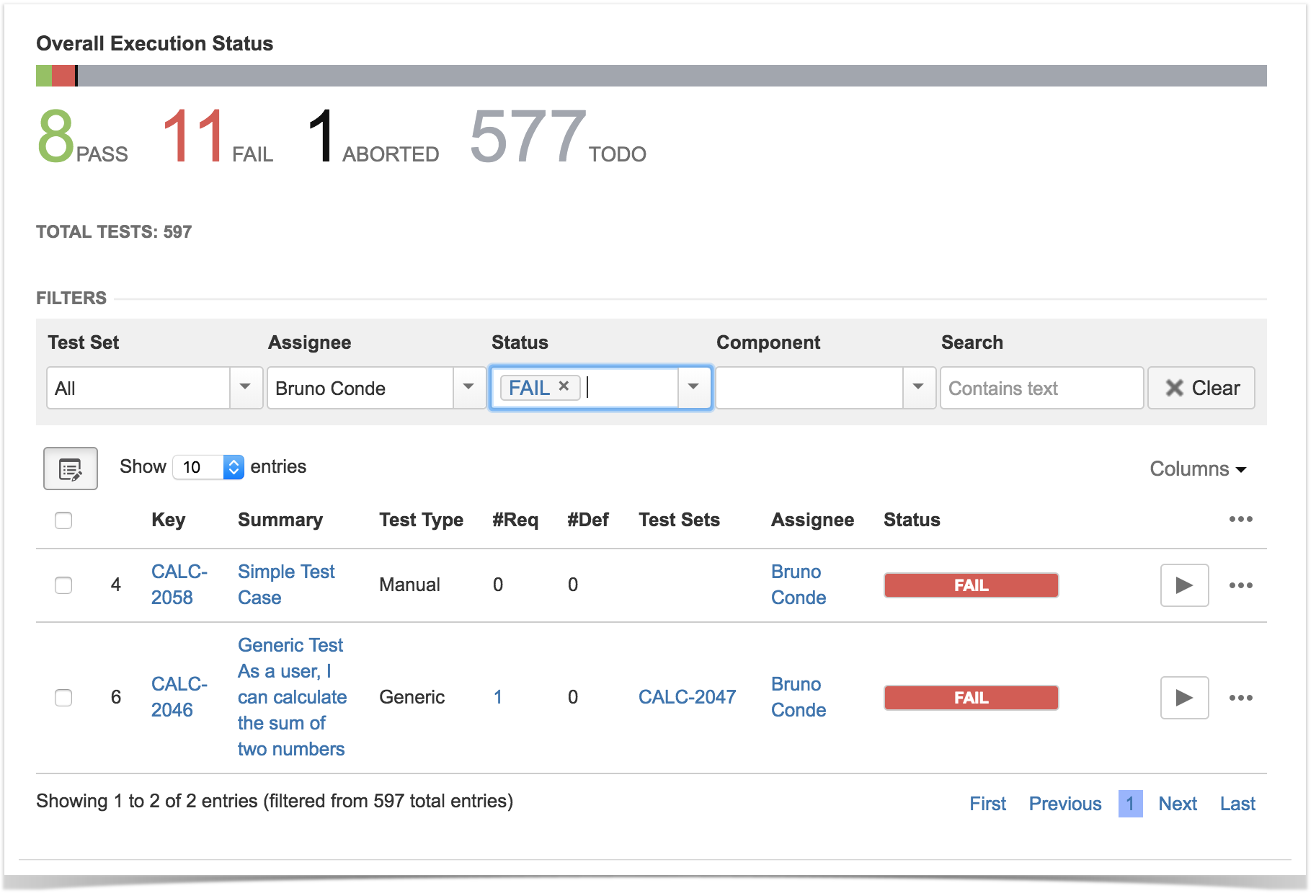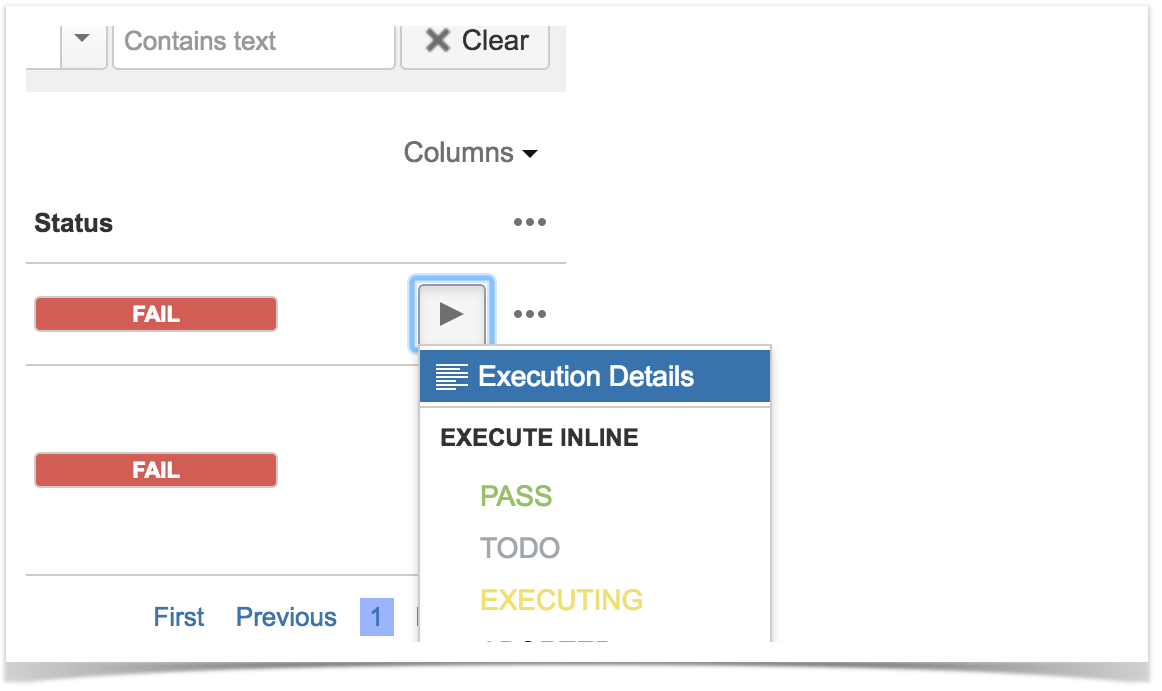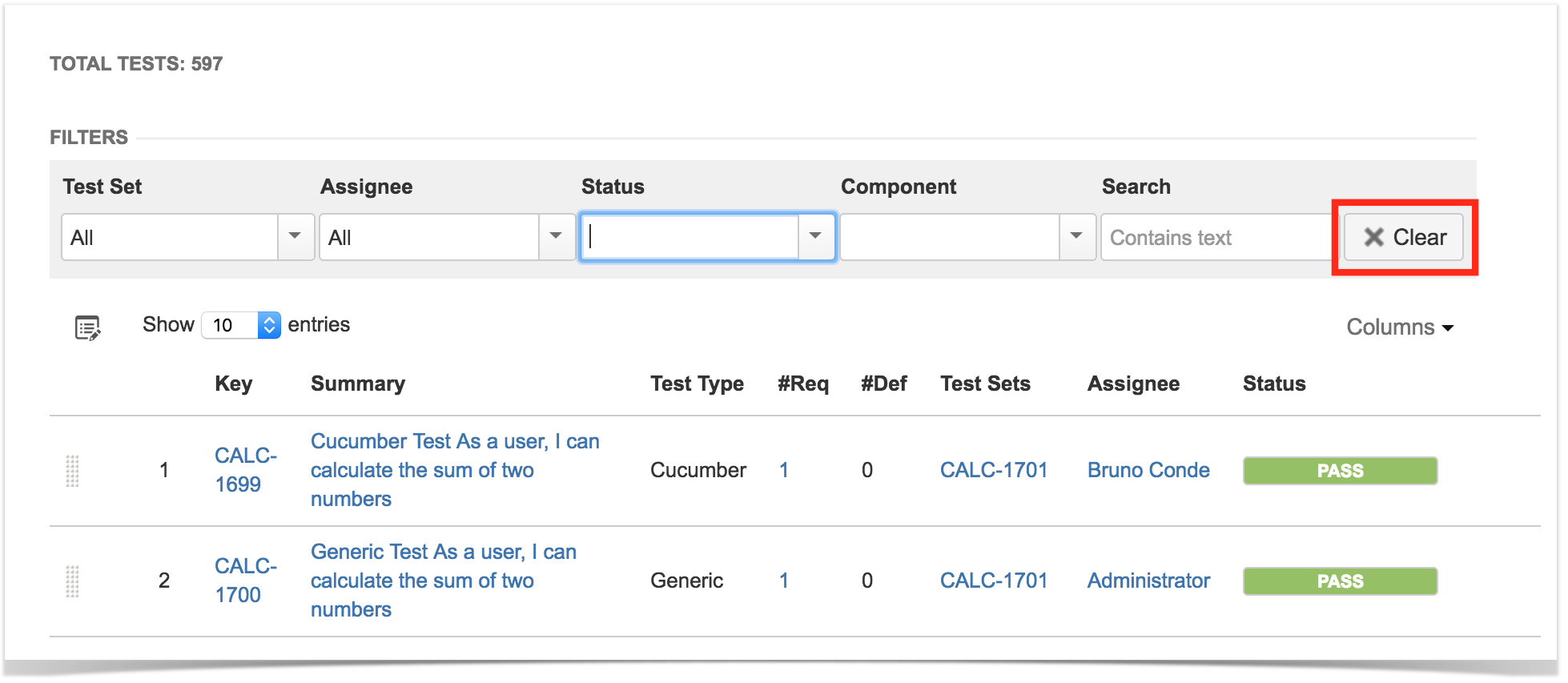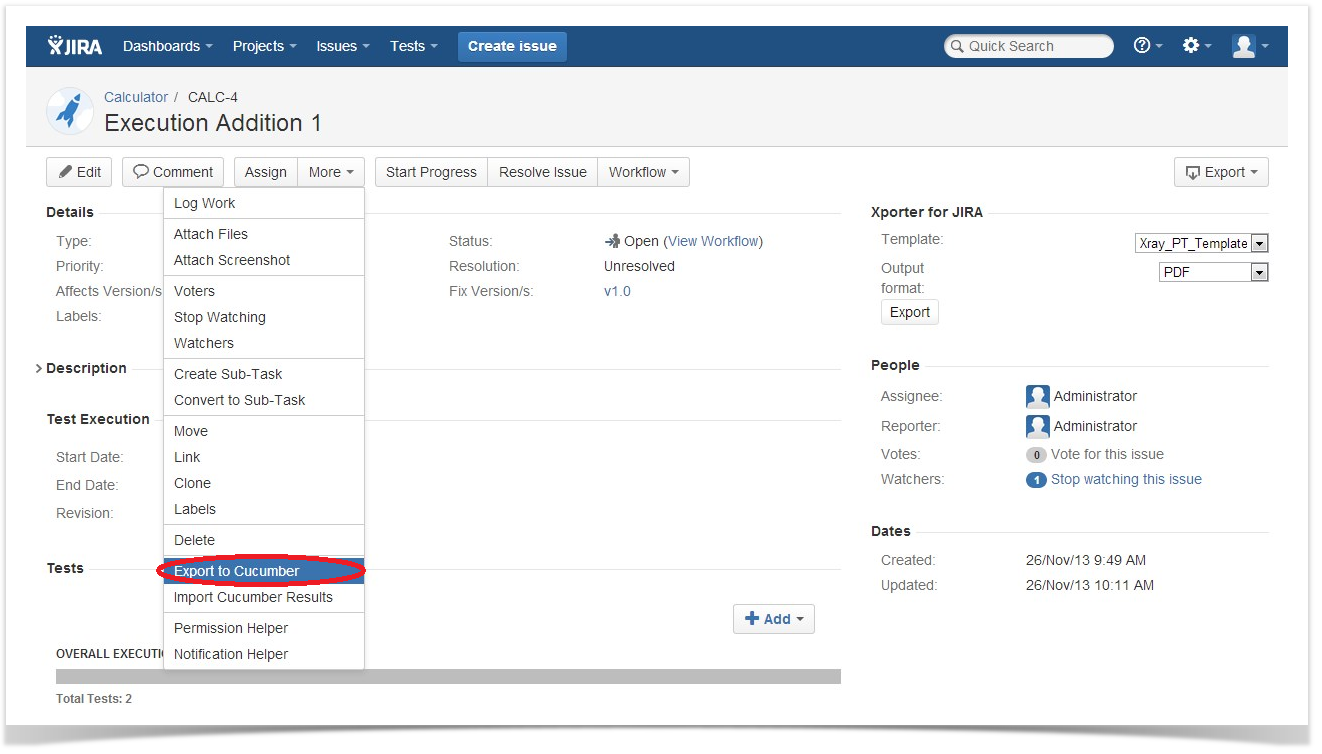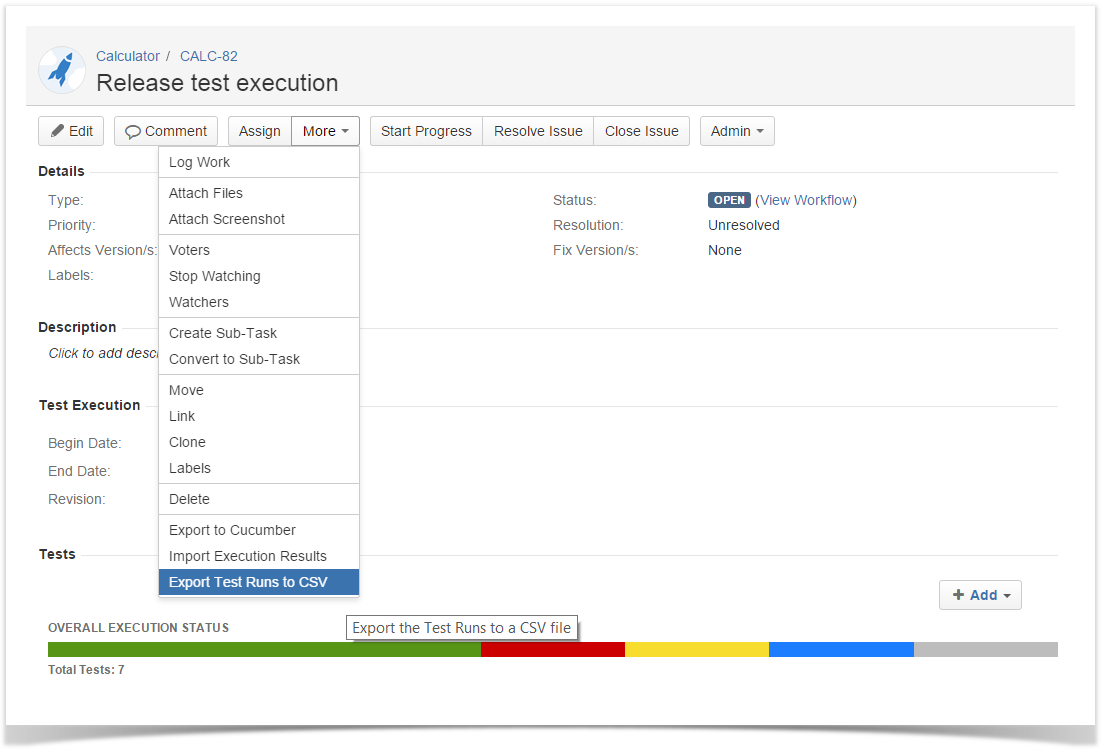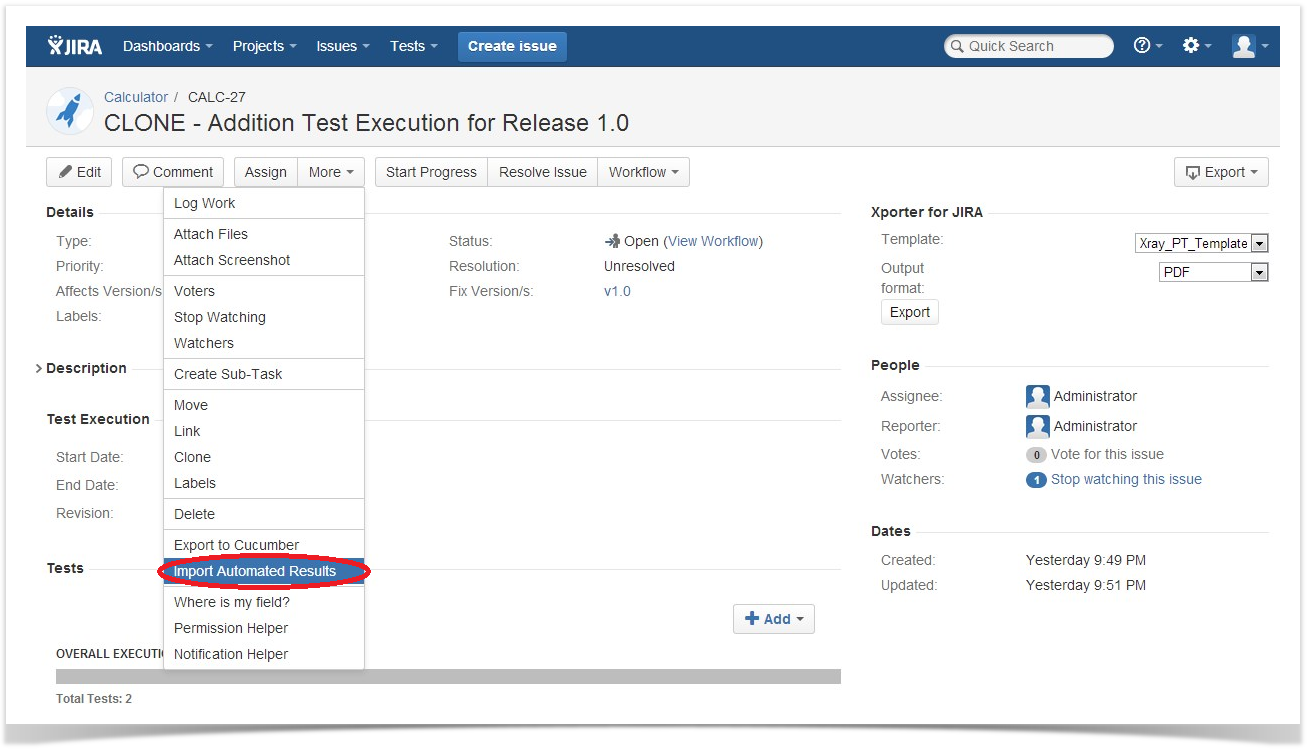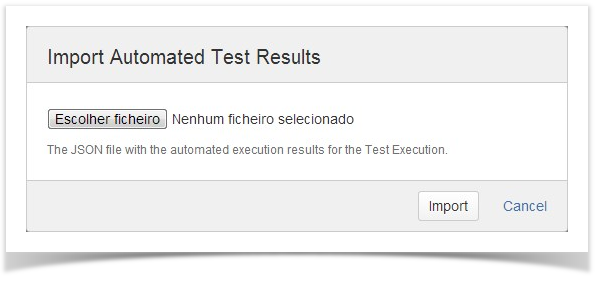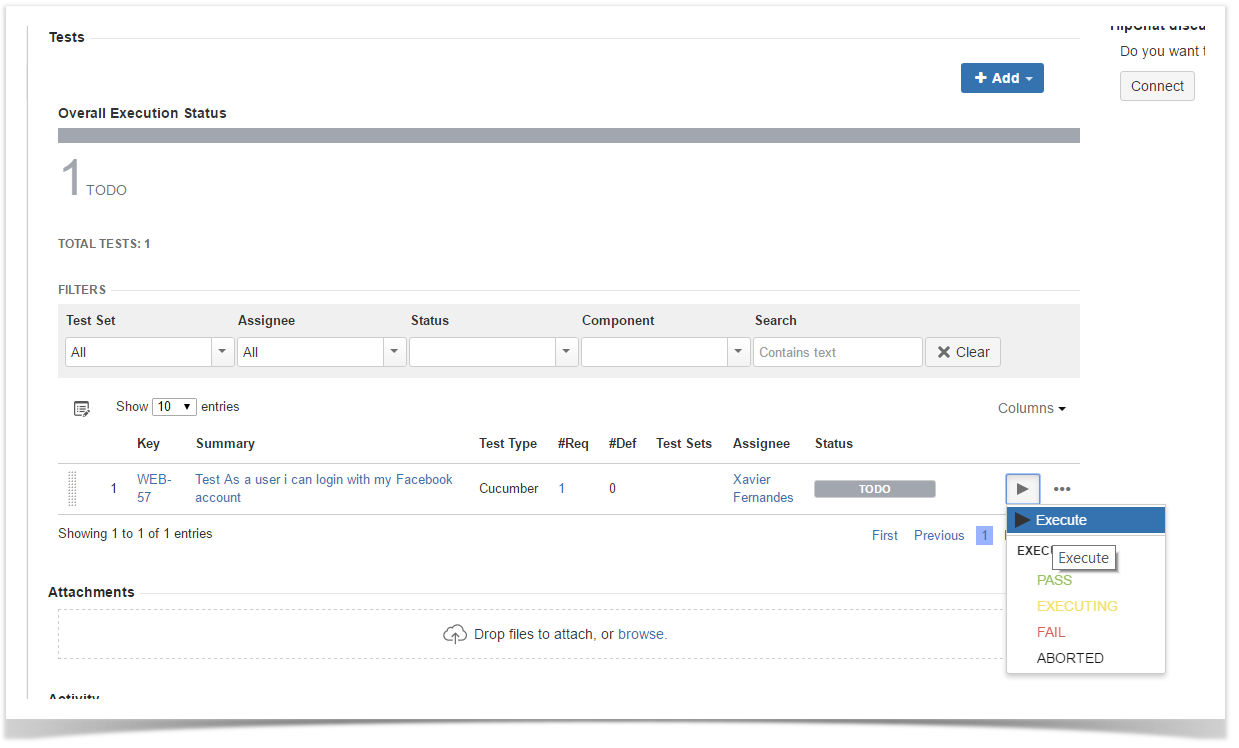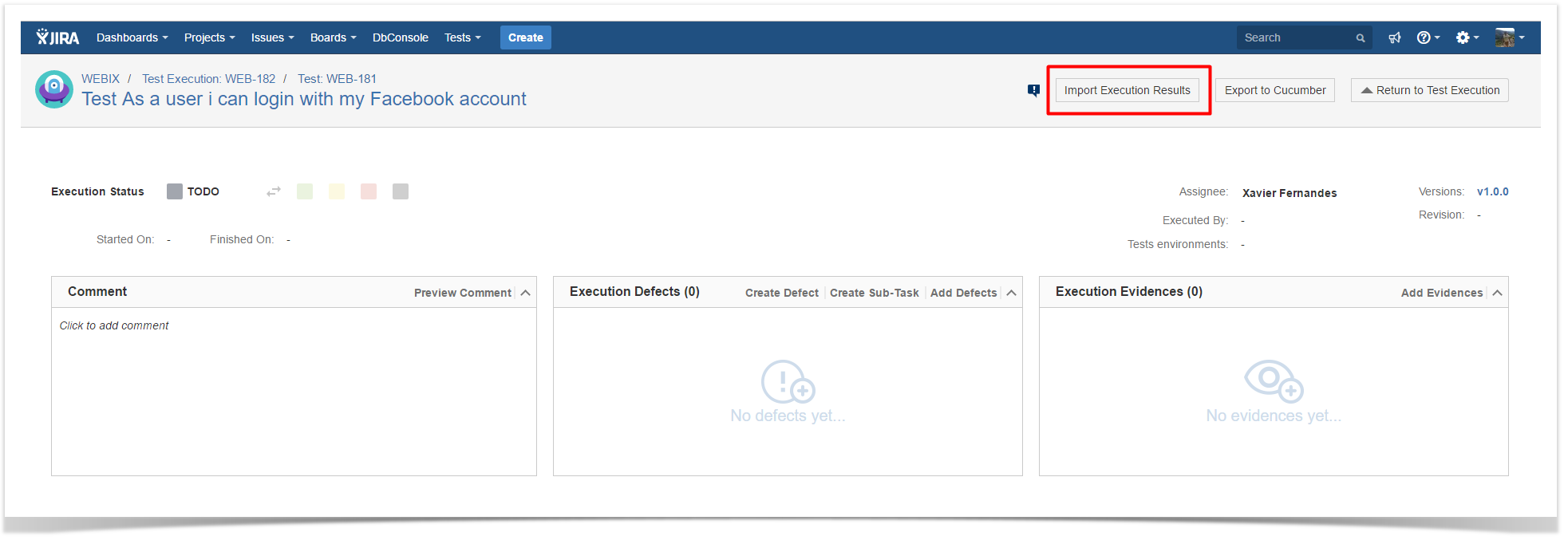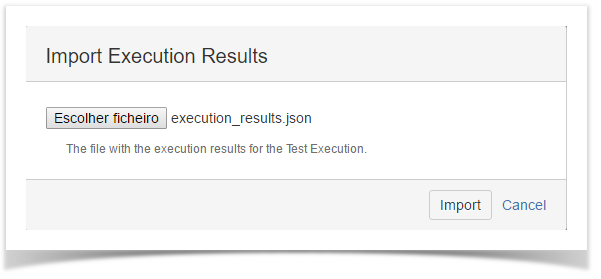Page History
...
This view has a colored progress bar where you can clearly see the status of a Test Execution. Final statuses float to the left side; the last status color to appear is the TODO status.
It is possible to filter tests by status in Test Execution Progress Bar as shown in the image below:
Test Run Filters
A filter section is also present above the Test Runs table to allow you to filter Test Runs by Assignee, Status, Test Set, or open text.
...
The #Def column provides the number of Defects created during the Test Execution or already related to the Test issue. For more information on how the calculation is done for this field, please refer to Defects Count.
Actions
| Table of Contents | ||||
|---|---|---|---|---|
|
| Info | ||
|---|---|---|
| ||
Now it is possible to filter tests by clicking on "Overall Execution Status" in Test Execution Progress Bar |
Create
To create a new Test Execution Issue,
...
Step 3: Edit the clone Test Set's Summary if you wish.
Step 4: Click Create.
...
Adding Tests
...
Tests and Test Sets can be associated with Test Execution issues.
...
Add Tests
To add Test issues to a Test Execution:
...
- Browse for the desired Test Project, Type or terms it Contains.
- Click on the More button to add more browse fields such as Label, Test Set, Test Set Fix Version, Requirement, Requirement Fix Version, Saved Filter and Workflow Status.
- Click on the Magnifier button after filling out the browse fields to get a list of matching entries
- Click on the Advanced button to perform a JQL search.
Step 4: Click Add.
...
Add Tests from Test Sets
When adding a Test Set issue with to a Test Execution, all the Test issues associated with the Test Set are added to the Test Execution. The Test Set issue is not directly associated with a Test Execution, so changes to the Test Set after it was added will not affect the Test Execution.
Step 1: Open the Test Execution you wish to associate a Test Set with.
...
- Input the desired Test Set Issue Key on the Test Sets field.
- Click on the Down Arrow on the Test Sets field and select the Test Set from its History Search list.
- Click on the + button wich will prompt an Issue Selector Pop-Up.
- Click on the Search tab to use the Find Jira issues browser.
| Info | ||
|---|---|---|
| ||
Notice the setting for ignoring Tests in non-executable statuses at the bottom-left side. By default it will be selected, therefore restricting the shown Tests available for adding accordingly to the configuration "Disallow executions of Tests with workflow statuses". |
Search Test Sets Issues - In order to search for Test Sets to be associatedassoci.ated, you can, under the Search tab:
- Browse for the desired Test Set Project or terms it Contains.
- Click on the More button to add more browse fields such as Label, Fix Version, Saved Filter and Workflow Status.
- Click on the Magnifier button after filling out the browse fields to get a list of matching entries.
- Click on the Advanced button to perform a JQL search.
| Info | ||
|---|---|---|
| ||
Notice the setting for ignoring Tests in non-executable statuses at the bottom-left side. By default it will be selected, therefore restricting the shown Tests available for adding accordingly to the configuration "Disallow executions of Tests with workflow statuses". |
Step 4: Click Add.
Associate with a Test Plan
You can associate Test Executions with Test Plans by editing the custom field Test Plan in the Test Execution issue view page, or directly in the create issue screen in the Test Execution Details tab.
If the Test Execution is associated with a Test Plan and contains Tests that are not in the Test Plan, a warning message will be displayed telling you how many tests in the Test Execution are not in the Test Plan with a button to add these tests to the Test Plan.
...
There will be one warning message for each Test Plan associated with the Test Execution that does not contain all the Tests in the Test Execution.
...
Remove Tests
| Section | ||||
|---|---|---|---|---|
|
Assigning Work
| Section | ||||
|---|---|---|---|---|
There are two ways to distribute work between Testers.
|
...
| Section | ||||
|---|---|---|---|---|
|
Execute Test
To execute a Test from a Test Execution:
...
You can see a detailed explanation of the execution screen here.
Note: If you does not have permission to execute the Test Run, the "Run" option will not be available.
Execute Test Inline
| Info | ||
|---|---|---|
| ||
This action may trigger some email notification(s) depending on your Xray settings. For more info on email notifications and how to set-up them, please have a look at Test Run Email Notifications. |
Execute Test Inline
To execute Test Runs inline from the Test Execution view screen, this option must be enabled in the Xray administration page. To execute Test Runs inline from the Test Execution view screen, this option must be enabled in the Xray administration page. The option for setting the Test Run status manually without having to execute all Test Steps (or Examples, in the case of Cucumber Tests) must also be enabled in the Xray administration page.
...
Step 2: Click the Execute button located in the last column of the Test Runs table and select one of the available statuses.
View Test Run Details
| Info | ||
|---|---|---|
| ||
This action may trigger some email notification(s) depending on your Xray settings. For more info on email notifications and how to set-up them, please have a look at Test Run Email Notifications. |
View Test Run Details
You can always view and You can always view and modify the Test Run details after execution. If you do not have permission to execute the Test Run, you can still view the execution details in read-only mode, given that you have permission to browse the Test Execution issue.
...
Step 1: Open the Test Execution issue.
Step 2: Click on the Bulk button to activate the bulk edit mode (under the Tests section on the view page). A checkbox appears Select the desired Test Runs. This can be done by using the checkbox that appears on each Test Run row . The bulk actions button appears in the actions column header.
Step 3: Select the desired Test Runs.
or, since v3.1, by using the Bulk dropdown button options for easy selecting all Test Runs or the ones in the current page.
| Info | ||
|---|---|---|
| ||
As of v3.1, the selection will be preserved even if you navigate between pages. |
Step 3Step 4: Click the bulk actions gear located on the actions column header and choose one of the available actions.
| Info |
|---|
Filter Test Runs
To filter the Test Runs table, select the desired filters in the filters section above the Test Runs table.
| ||
Bulk operations may trigger some email notification(s) depending on your Xray settings. For more info on email notifications and how to set-up them, please have a look at Test Run Email Notifications. |
Filter Test Runs
To filter the Test Runs table, select the desired filters in the filters section above the Test Runs table.
- Test Set - show only Test Runs that are associated with a specific Test Set issue.
- Assignee - show only Test Runs that are assigned to a specific user.
- Status - show only Test Runs with a specific
- Test Set - show only Test Runs that are associated with a specific Test Set issue.
- Assignee - show only Test Runs that are assigned to a specific user.
- Status - show only Test Runs with a specific status.
- Contains Text - show only Test Runs with Tests containing the entered text. This will query Test issues with the JQL keyword text ~ ...
Configure Test Run Columns
...
Xray provides the ability to configure columns for the Test Runs table. This configuration is specific to each user and can be restored to the default configuration defined in the Global Preferences page in Xray's administration.
The first and last columns (Test Run Rank and Status, respectively) are fixed and cannot be removed from the table.
To configure columns for the Test Runs table,
Step 1: Open the Test Execution issue.
Step 2: Click on the Columns, select the dropdown that appears above the table in the top-right corner. A list of the current configure columns and all available columns appears.
Step 3: Add or remove columns by clicking the checkboxes next to each field.
Step 4: Click the Done button when finished or Cancel to abort this operation. The table refreshes with the configured columns.
Test Run-Specific Columns
The following columns are not Jira fields, but they represent information stored internally by Xray for Test Runs. You can also choose these columns for your layout.
...
Restoring Columns to Default Configuration
To restore columns in the Test Runs table to the default configuration,
Step 1: Open the Test Execution issue.
Step 2: Click on the Columns, select the dropdown that appears above the table in the top-right corner. A list of the current configure columns and all available columns appears.
Step 3: Click the Restore Columns link above the columns list. The table refreshes with the default configured columns.
Change Columns Order
To reorder columns in the Test Runs table,
Step 1: Open the Test Execution issue.
Step 2: Hover over the desired column header.
Step 3: Click on the column header and drag it to the desired position.
Since v3.1, the filters will be stored in the user and Test Execution context, and will be applied whenever going into the execution screen from one of the filtered Tests.
The execution screen shows a small notice, so you can quickly identify that the filter has been applied thus affecting the navigation options (Previous/Next) available in the execution screen.
If you decide to come back to the Test Execution issue screen, the filter will remain. If you wish, you can clear the filter in order to see all Test Runs once again.
Configure Test Run Columns
More info in Test Runs.
Export to Cucumber
Cucumber Test Executions in JIRA can be exported to feature files ready to be executed in Cucumber. The generated feature files follow the rules defined in Export Rules and take into account the context of the Jira Test Execution issue.
A single Cucumber feature file should be generated and prompted to be downloaded for the Cucumber Test contained on the Test Execution, unless the target Test Execution contains multiple Cucumber Tests or the Cucumber Test is associated with multiple Requirements. In this case, a FeatureBundle zip file will be generated containing a single Cucumber feature file for every Requirement associated with the target Cucumber Test contained on the Test Execution.
To export a Test Execution issue containing Cucumber Tests to feature files,
Step 1: Open the Test Execution issue view page.
Step 2: Select More > Export to Cucumber. The file will be downloaded from the browser.
Export Test Runs to CSV
Xray Test Runs can be exported to CSV. The Xray export action will export to CSV the most relevant fields for Test Runs such as:
- Test Key
- Test Execution Key
- Executed By
- Assignee
- Start
- Finish
- Defects issue keys (list separated by ",")
- Attachment Jira links (list separated by ",")
- Comment
- Status
To export a Test Run to CSV,
Step 1: Open the Test Execution issue view page.
Step 2: Select More > Export Test Runs to CSV. The resulting CSV file will be downloaded to the browser.
Import Automated Test Results
Importing from Test Execution view issue screen
Automated Test results can be imported back to Jira using the Test Execution view issue screen. The Test results can be imported from JSON/XML external files that must follow an Import Results specific scheme.
When importing results, only the Tests contained in the interception between the Tests in the JSON/XML file and the Tests in the selected Test Execution are updated, while the remaining, if any, are ignored. After importing, a new entry with the result of the operation is registered in the Activity Log of the Test Run.
To import Automated Test results to a Test Execution issue containing automated Tests,
Step 1: Open the Test Execution issue view page.
Step 2: Select More > Import Automated Results. The Import Automated Test Results dialog will be prompted.
Step 3: Click the Browse button to navigate to the local disk and select the JSON/XML/ZIP file with the automated execution results for the Test Execution.
Step 4: Click Import.
Importing from the Execution Details Page
You can also import the Automated Test results from the Execution Details page:
Step1: From Test Execution view issue screen, go to the Execution Details page by clicking Execute (or by
clicking Execution Details if the test has been previously executed).
Step 2: Click the Import Execution Results button.
| Column |
|---|
Export to Cucumber
Cucumber Test Executions in JIRA can be exported to feature files ready to be executed in Cucumber. The generated feature files follow the rules defined in Export Rules and take into account the context of the Jira Test Execution issue.
A single Cucumber feature file should be generated and prompted to be downloaded for the Cucumber Test contained on the Test Execution, unless the target Test Execution contains multiple Cucumber Tests or the Cucumber Test is associated with multiple Requirements. In this case, a FeatureBundle zip file will be generated containing a single Cucumber feature file for every Requirement associated with the target Cucumber Test contained on the Test Execution.
To export a Test Execution issue containing Cucumber Tests to feature files,
Step 1: Open the Test Execution issue view page.
Step 2: Select More > Export to Cucumber. The file will be downloaded from the browser.
Export Test Runs to CSV
Xray Test Runs can be exported to CSV. The Xray export action will export to CSV the most relevant fields for Test Runs such as:
- Test Key
- Test Execution Key
- Executed By
- Assignee
- Start
- Finish
- Defects issue keys (list separated by ",")
- Attachment Jira links (list separated by ",")
- Comment
- Status
To export a Test Run to CSV,
...
Step 2: Select More > Export Test Runs to CSV. The resulting CSV file will be downloaded to the browser.
Import Automated Test Results
Importing from Test Execution view issue screen
Automated Test results can be imported back to Jira using the Test Execution view issue screen. The Test results can be imported from JSON/XML external files that must follow an Import Results specific scheme.
When importing results, only the Tests contained in the interception between the Tests in the JSON/XML file and the Tests in the selected Test Execution are updated, while the remaining, if any, are ignored. After importing, a new entry with the result of the operation is registered in the Activity Log of the Test Run.
To import Automated Test results to a Test Execution issue containing automated Tests,
Step 1: Open the Test Execution issue view page.
Step 2: Select More > Import Automated Results. The Import Automated Test Results dialog will be prompted.
Step 3: Click the Browse button to navigate to the local disk and select the JSON/XML/ZIP file with the automated execution results for the Test Execution.
Step 4: Click Import.
Importing from the Execution Details Page
You can also import the Automated Test results from the Execution Details page:
Step1: From Test Execution view issue screen, go to the Execution Details page by clicking Execute (or by
clicking Execution Details if the test has been previously executed).
Step 2: Click the Import Execution Results button.
Step 3: Click the Browse button to navigate the local disk and select the JSON/XML/ZIP file with the automated execution results for the Test Execution.
Step 4: Click Import.
Now it is possible to filter tests by clicking on "Overall Execution Status" in Test Plans Progress Bar.
| Info |
|---|
Now it is possible to view the associated Test Plans of a given Test in the Execution Details view page as shown below. |

